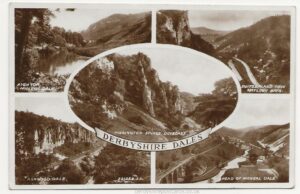Derbyshire Dales from the Derbyshire Heritage website where there is a fairly comprehensive list of Derbyshire Dales and their locations –
The limestone dales of Derbyshire and the Peak District offer some of the most accessible, beautiful and spectacular scenery. Crystal clear water flows through the dales which are often flanked by precipitous cliffs and pinnacles or tors.
Dales such as Dovedale and Lathkill Dale are extremely popular and can get very busy but there are large number of lesser known ones which are sometimes less accessible but equally as beautiful.
Due to specific geology some of the dales run dry and the crystal clear water can disappear only to reappear further downstream.
According to Natural England the Derbyshire Dales Nature Reserve is made up of five dales which they manage : Lathkill, Cressbrook, Hay, Long and Monk’s Dale. See their brochure as it gives a wealth of information.
There are few sources relating to Derbyshire Dales.
Lord Byron once wrote that Derbyshire contains attractions ”as noble as in Greece or Switzerland,” .
“Interestingly an account of a visit by William Wordsworth to Dovedale from – Enlightenment! A blog by Buxton Museum and Art Gallery – All things Derbyshire in the eighteenth century –
The poet William Wordsworth (1770-1850), and his sister Dorothy (1771-1855), mention seeing Dovedale several times in their extensive writings. Though visiting the valley was never the specific purpose of one of their journeys, it was a picturesque location that they evidently sought-out as they travelled, that occasioned the siblings a great deal of pleasure. William Wordsworth first wrote about visiting Dovedale in 1788, when he was travelling back to Hawkshead in Cumbria for the summer, upon completing his first year at Cambridge University. On the 8th June, he recorded,
Saw nothing particularly striking till I came to Ashburn. Arrived there on Sunday Evening – and rode over to Dovedale. Dovedale is a very narrow valley somewhat better than a mile in length, broken into five or six distinct parts, so that the views it affords are necessarily upon a small scale. The first scene that strikes you upon descending into the valley, is the River Dove fringed with sedge, and stopped with a variety of small tufts of Grass hurrying between two hills, one of which about six years ago was cloathed with wood; the wood is again getting forwards; the other had a number of cattle grazing upon it. The scene was pleasing – the sun was just sinking behind the hill on the left – which was dark – while his beams cast a faint golden tinge upon the side of the other. The River in that part which was streamy had a glittering splendor which was pleasingly chastised, by the blue tint of intervening pieces of calm water; the fringe of sedge and the number of small islands, with which it is variegated. The view is terminated by a number of rocks scattered upon the side of one of the hills of a form perfectly spiral –”
A unique out-of-print book entitled ‘The Derbyshire Dales’ from 1953 by Norman Price who says “it is possible in Derbyshire to escape further from the footprints of other men than anywhere else in England.” and describes his impressions of many of the ‘classic’ Derbyshire Dales.


